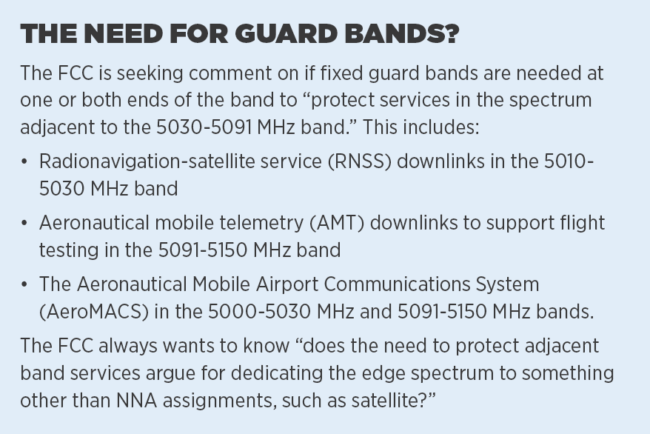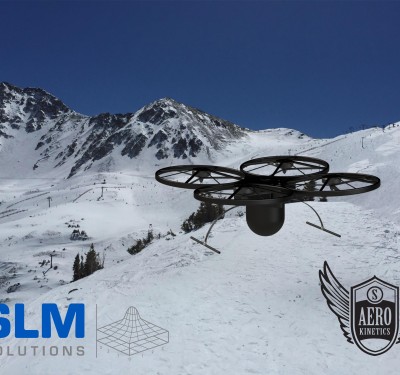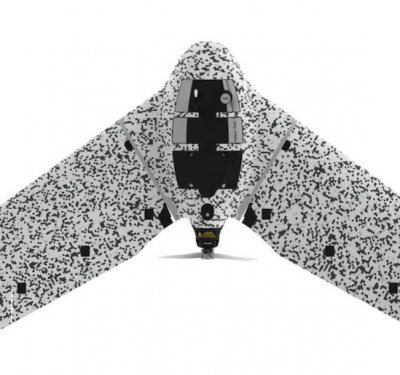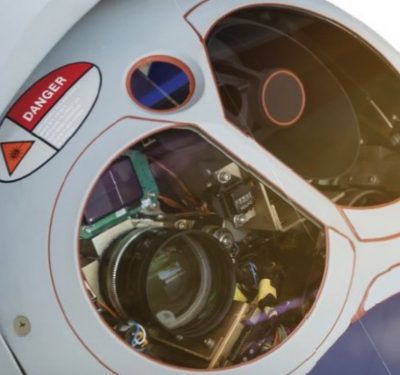
In early February, the Federal Communications Commission (FCC) took a big step forward in opening new spectrum for unmanned aircraft operations, publishing a notice of proposed rulemaking in the Federal Register.
The rulemaking focuses on the 5030-5091 MHz band. Earlier proposals would have added spectrum in the 960-1164 MHz band, and those still may be considered, but for now the FCC is focusing on the higher bandwidth. The lower bandwidth was rejected because of concerns about interference with some satellite navigation systems, although those concerns haven’t been entirely mitigated.
“It is past time that we assess the availability of wireless communications resources for the increasingly important remote-piloted aircraft activity we rely on today,” FCC Chair Jessica Rosenworcel said in a Jan. 4 statement announcing the pending Notice of Proposed Rulemaking (NPRM). “The FCC must ensure that our spectrum rules meet the current—and future—spectrum needs of evolving technologies such as unmanned aircraft systems, which can be critical to disaster recovery, first responder rescue efforts, and wildfire management.”
The NPRM was published in the Federal Register on Feb. 7, kicking off a 30-day comment period and a 60-day response period. In a nutshell, the rulemaking would allow unmanned aircraft to access spectrum needed for safety-critical communications links, and would create a process for UAS operators to get a license in the aeronautical VHF band to talk to air traffic control and other aircraft.
Brent Skorup, a senior research fellow at the Mercatus Center at George Mason University in Virginia, who has followed the rulemaking process for years, said he expects considerable reaction to the proposed rule. “This is a large band of spectrum and it’s pretty much green field,” he said. “There aren’t many users in it, and that’s rare to find.”
It is, as the FCC describes it, a “first step” to develop such rules, and the NPRM filing notes more are likely coming. For instance, two companies have a pending petition for rulemaking to allow the 450 MHz General Aviation Air-Ground Radiotelephone Service band to be used for a broader range of services, including data communications with unmanned aircraft. The FCC expects to address that in another proceeding.
THE NEED
Unmanned aircraft (UA) rely on wireless communications to control the aircraft and receive information from it, as well as for safety-related purposes, such as detecting other aircraft.
IT IS PAST TIME THAT WE ASSES THE AVAILABILITY OF WIRELESS COMMUNICATIONS RESOURCES FOR THE INCREASINGLY IMPORTANT REMOTE-PILOTED AIRCRAFT ACTIVITY WE RELY ON TODAY.
Jessica Rosenworcel, Chair, FCC
Right now, there isn’t a spectrum licensed exclusively for UAS communication in the U.S., according to the document, so operators typically rely on unlicensed operations or experimental licenses.
Hacking and spoofing communication signals to drones has become a large concern in recent years, and the rulemaking document notes that’s partly because of the type of spectrum the systems are using. Neither of the current spectrum resources “provide the user with any right to protection from harmful interference, and as a result, the reliability of communications using these resources can be uncertain,” according to the document.
“As UA flights increasingly involve operations with a higher risk profile, such as flights that use large aircraft, carry heavy cargo or human passengers, or travel into the controlled airspace used by commercial passenger aircraft, operators have a growing need for the greater reliability that interference-protected licensed spectrum provides for control-related and other safety-related communications.”
THE HISTORY
The FCC and other agencies have been discussing spectrum needs for UAS for years. Before the World Radiocommunication Conference (WRC) of 2012, the 5030-5091 MHz band was allocated to the Aeronautical Mobile Satellite (Route) Service, or AMS(R)S, and the Aeronautical Navigation Service, or ARNS, although the microwave landing system for precision aircraft approach was given priority.
At the 2012 WRC, the United States proposed the band also should be allocated to the AMS(R)S on a primary basis to support terrestrial control links for UAS, as their growth was anticipated and the microwave landing system wasn’t using those frequencies in the United States. That proposal was adopted.
In a 2017 follow-up to the 2012 conference, the WRC defined AM(R)S as “an aeronautical mobile service reserved for communications relating to safety and regularity of flight, primarily along national or international civil air routes” and said adopting the new AM(R)S allocation would “support the anticipated growth of UAS and promote their safe operation.” The commission did not adopt any rules to license or govern UAS services in the band, saying that would come later.
A year later, the Aerospace Industries Association filed a petition for rulemaking for licensing and service rules for control and non-payload communications (CNPC) links in the 5030-5091 MHz band to support UAS operations in the United States. It suggested prohibiting any non-UAS use of the band or any UAS use for payload communications or other “non-safety or non-route” services.
The FCC sought public comment on that idea, and of the eight responders who commented, most support beginning the rulemaking. Some noted the AIA proposal was too restrictive in the operations it would support, and some felt the 505-5091 MHz band wouldn’t be enough to support all UAS operations, so the FCC shouldn’t preclude the use of other bands as well.
In 2018, Section 374 of the FAA Reauthorization Act required the FAA, the FCC and the National Telecommunications and Information Administration (NTIA) to report to congressional committees on whether UAS should be permitted to use the 5030-5091 MHz band. In November 2019, the Office of Engineering and Technology (OET) and the Wireless Telecommunications Bureau (WTB) sought public comment on that proposal, which at the time included the 960-1164 MHz band.
Some respondents expressed concern about the 960-1164 MHz band, also known as the L band. One was the GPS Innovation Alliance, which noted that GPS and GNSS systems, as well as augmentations to GNSS systems, operate in various bands including the 1164-1215 MHz band, which is allocated to the Radio Navigation Satellite Service (RNSS), a “safety of life” service used in GPS, Galileo, GLONASS, BeiDou and other GNSS platforms.
The alliance said it had no position on whether UAS operations should be allowed in the 960-1164 band, but wanted to protect RNSS operations in the higher band. A WRC resolution protects RNSS, GPS and GNSS against “harmful interference that AM(R)S systems in the adjacent 960-1164 MHz band may cause.”
The FCC ultimately agreed. In the summer of 2020, the OTE and the WTB submitted a report to Congress on behalf of the FCC that said the 5030-5091 MHz band “appears to offer promise for intensive UAS use because it is unencumbered” and recommended the FCC begin rulemaking.
As for the 960-1164 MHz band, “the record reflects significant concern regarding the impacts of potential UAS operations on incumbent aeronautical navigation operations in the 960-1164 MHz band. We do not recommend moving forward with a proceeding to make the 960-1164 MHz band available for UAS operations at this time,” according to the report. “We recommend that the commission continue to study the use of this band for UAS purposes, and to work with the FAA, NTIA, and other stakeholders regarding appropriate UAS rules and policies in the event that circumstances warrant initiating a rulemaking for this band.”
PROPOSAL TO PARTITION
The rulemaking proposes to partition the 5030-5091 MHz band, dedicating different segments to line-of-sight operations and beyond-line-of-sight operations, which it describes as Non-Networked Access (NNA) and Network-Supported Service (NSS), respectively.
“To accommodate both NNA and NSS in the 5030-5091 MHz band, we propose to partition the band, to dedicate different segments of spectrum in the band for each use case, and to license each of these segments in a manner that is appropriate to support the relevant use cases,” according to the rulemaking document.
But how should that partitioning work? The rule proposes to dedicate at least 10 megahertz of spectrum for NNA operations. The FCC wants input on how that partition should work: 5 megahertz blocks on either end of the band, or somewhere in the middle? And, how much of the band should be reserved for NSS operations?
Access to the band would be managed by what the FCC calls dynamic frequency management systems (DFMS), private, third-party managers that would receive requests from operators for frequency assignments and then assign the temporary frequencies through an automated system. The FCC notes this approach has worked well for other bands, such as the Citizens Broadband Radio Service, but asks for comments on the idea.
SATELLITE CONCERNS
The issue of interference with satellite-based navigation systems isn’t quite settled. The FCC is seeking comment on an analysis from the Radio Technical Commission for Aeronautics (RTCA) that suggested the use of “guard bands” to keep the bands used for control and non-payload communications for UAS from interfering with satellite navigation bands up the spectrum.

Skorup said he wouldn’t be surprised to see guard bands in the final rule, “on the edges of this new block of spectrum, perhaps low-power systems on the edges, to protect the adjacent aeronautics bands.”
Elsewhere in the document, the FCC says, “We further seek comment on whether we should preserve part of the band at this time for experimental use, or for potential future satellite-based CNPC that relies on the AMS(R)S allocation in the band.”
INTERNATIONAL CONCERNS
Some commenters have suggested the FCC adopt the technical requirements of the RTCA DO-362A standard for NNA equipment and operations, by which it means line of sight operations. For instance, the standard sets requirements for CNPC links, which would be limited to communications between a UAS and its control station. The FCC says it does plan to adopt that, but had some questions, particularly about potential interference with international standards.
“Canada states that some technical incompatibilities have been identified between RTCA DO-362A and a proposed standard by the European Organization for Civil Aviation Equipment (EUROCAE) for satellite-based CNPC in the same band, designated draft ED-265, and asserts that adoption of the RTCA DO-362A standard without addressing the incompatibilities may create difficulties in managing the operation of CNPC links in support of international UAS operations,” according to the NPRM document. The FCC would like to know more.
This could delay the final rulemaking, the document notes: “If revisions to RTCA DO-362A are necessary or appropriate to address these issues, we seek comment on whether the next version of the standard is anticipated to be backwardly compatible with RTCA DO-362A, and if not, whether adoption of final rules should be deferred until these issues are resolved in a new version of the standard.”
SATELLITE OPERATIONS
The NPRM document has many questions about potential satellite networks for drone operation. The 5030-5091 MHz band, it notes, is already set aside for ASM(R)S, which would support control and non-payload communications.
“AIA’s petition for rulemaking, however, did not request or propose that any provision be made for satellite services in the band, and no party in the current record has proposed such an option,” according to the document.
The FCC asks anyway: Should NSS (that is, BVLOS) licensees be allowed to use satellite services for UAS control? “For example, would satellite be a feasible and desirable means of deploying a CNPC-focused network with the ubiquitous coverage needed to support long-range operations, particularly those operations that may occur in remote areas and over oceanic regions or other large bodies of water?” Later, it speculates whether guard bands would be necessary for this use as well, to avoid interference with the ASM(R)S and RNSS.
FINAL RULE
With all of the outstanding questions still not resolved, and another few months of comments and replies waiting, it’s unclear when a final rule will appear.
An FCC spokesman said the agency can’t speculate on a timeline, but “will review the public record generated in the proceeding before taking any further steps.”
Skorup said he’s not sure, either. “There’s a lot of unanswered questions. The proceeding raises more questions than it answers. They clearly have a direction they want to go, but there’s a lot of large, savvy parties in the aerospace industry, in the telecommunications industry, in the semiconductor industry, [and] government agencies also have an interest. It’s not clear what will come out in the end when you have all these industries debating the merits.






